FUNtain sustainable design sculptures
The FUNtain sculpture is an interactive
sound sculpture that combines form, function, and frolic
at the nexus of art and science, and technology, as shown below:
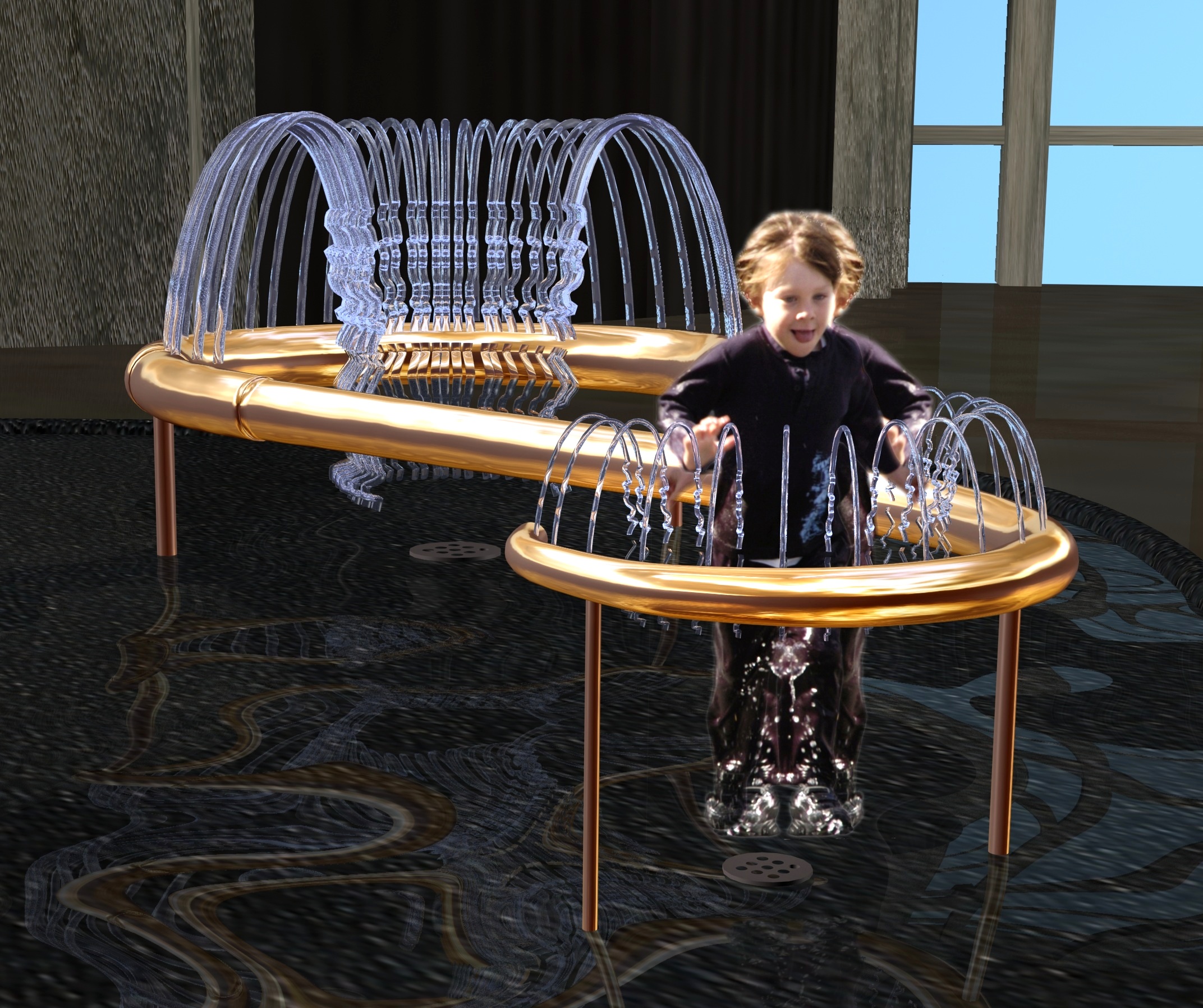 It functions as a musical instrument ---
a water instrument
that is played like a flute, by blocking various holes
along the length of the sculpture. But instead of blocking air as
with a flute, the sculpture is played by blocking water jets.
It functions as a musical instrument ---
a water instrument
that is played like a flute, by blocking various holes
along the length of the sculpture. But instead of blocking air as
with a flute, the sculpture is played by blocking water jets.
Thus it is a "woodwater" rather than a "woodwind" instrument.
The holes each spray out a fine stream of water, so that the sculpture has
a seductive and teasing quality that tend to draw people toward it,
to touch it, and when people block the various jets, it makes sound in
response to the blocking of the jets.
This interactive water fountain sculpture is called a ``FUNtain''
and each jet on the funtain corresponds to a note on the musical scale,
starting at ``A'', and moving through the musical alphabet, where each jet
is labeled as ``A, B, C, D, E, F, G, a, b, c, d, etc.''.
As people run their hands over the jets, a natural minor
scale is played on the whole notes from ``A'' to ``a''. This musical
scale is well suited to introspection and the contemplative atmosphere of
art/science exploration. You can play songs in a minor key,
like Summertime, Tarantella, or ``The Ants Go Marching'' starting on ``A''
or songs in a major key like ``The Wheels on the Bus Go 'Round and 'Round'',
starting on the third jet, ``C''.
Starting on jet ``D'' gives us the Dorian mode in which many traditional folk
songs such as ``What Shall We Do with the Drunken Sailor'' are played.
Starting with jet ``E'' gives us
the Phrygian mode (whole note jets ``E'' to ``e'') of flamenco music.
The FUNtain
creates its ineffable sense of awe and wonder in the way that it
connects to the basic element of water.
If a person stops and covers one of the jets (say, the letter ``A''
corresponding to 220 Hertz) the ``A'' note is sounded.
The shape of this funtain is suggestive of a treble clef. In making various
working prototypes of the funtain (a number of fully functional
working prototypes at Deconism Gallery, 330 Dundas Street West, which can be
demonstrated upon request), various shapes have been tested, and it was found
that the ``S'' shape is most conducive to interaction by casual passers by.
As part of the experiments, various funtains were setup on the sidewalk in front
of the studio, which is located directly across the street from the main
entrance to Art Gallery of Ontario, on a busy street. This provided
an ability to refine the design in a setting where it could be determined what
was most appealing to casual passers by. The ``S''
shape is more slender at one end (the end that sounds the upper part
of the treble clef for the higher notes).
This small end plays the higher notes of a melody line,
and is where participants
will typically find themselves attracted to, at first sight.
Water from the funtain is recirculated by way of
water collection on a small splash pad which is sloped
toward two drains under the funtain.
Various kinds of surfaces were tested, and it was
found that the best surface (non-slippery
when wet, etc.) was a surface that can be made from crumb rubber.
Recycled tyres are obtained from gas stations. Since tyres are hard to
dispose of, suppliers are very happy to give old tyres away for free.
To make a funtain base,
the tyres are frozen to very low subzero temperatures,
and smashed up, and the powder mixed with glue.
This mixture is poured around a hole in the floor for the floor drains.
There is a large floor drain at the big end of the funtain, and a smaller
floor drain at the small end. The crumb rubber is sloped toward the floor
drains, so that water runs toward the drains and thus the splash, fun,
frolic, and wetness is mostly contained on the splash pad area of the funtain.
The entire sculpture is to be run off renewable
energy (solar both for photovoltaics as well as heating of the water to make
the sculpture more comfortable to play and more ``FROLICious'', as well as
a Lakota 12 volt wind turbine).
This emphasis on renewable energy also provides further safety of materials
(electrical circuits, etc.) by way of an entirely ``off-grid'' installation.
I have also designed, built, and tested prototypes of the waterplay sculptures
with renewable energy, by creating an urban ``teach beach'' research
facility at the 330 Dundas Street studio. The design choices have been
a proven success (winning entry, first prize, in
the International CORAM Sustainable Design Competition in 2004 for a similar
kind of waterplay sculpture run on renewable energy;
see http://eyetap.org), so we are ready to move from the research prototype
to a nicely finished well-crafted version of the sculpture.
The general manner of interacting with the art can range from brief
encounters, running one's hand over the jets while walking by, to
more prolonged encounters, perhaps rolling up shirt sleeves and pant
legs. With research prototypes, participants began to play,
and then often had so much fun that they brought their bathing suits and
towels and many of their friends
the next time they came, to share in an experience of the
ineffable sense of awe and wonder.
Various versions of the FUNtain were built as research prototypes for
testing, and were used in a number
of successful live performances.
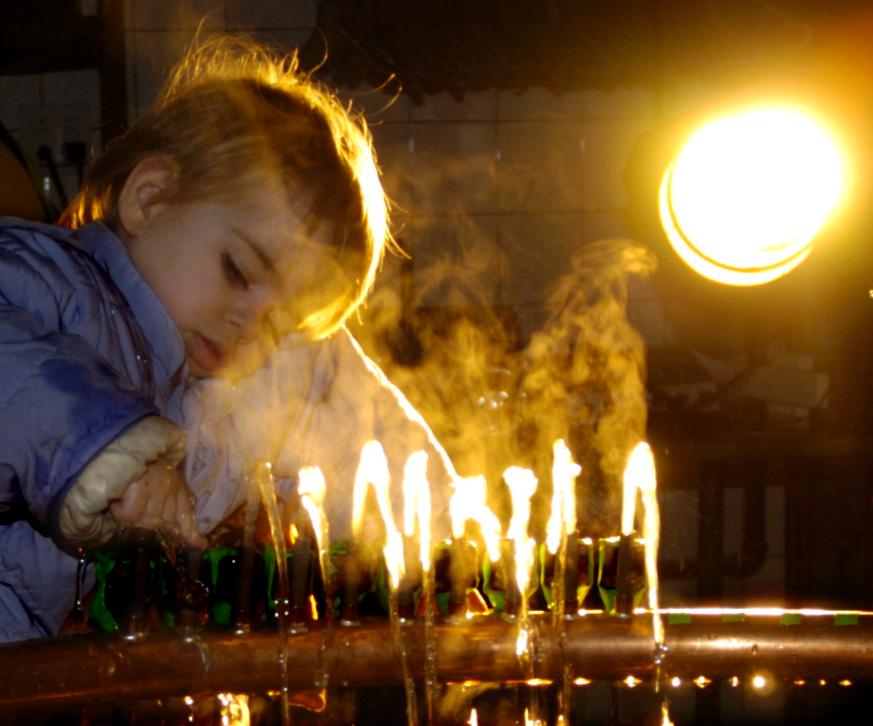
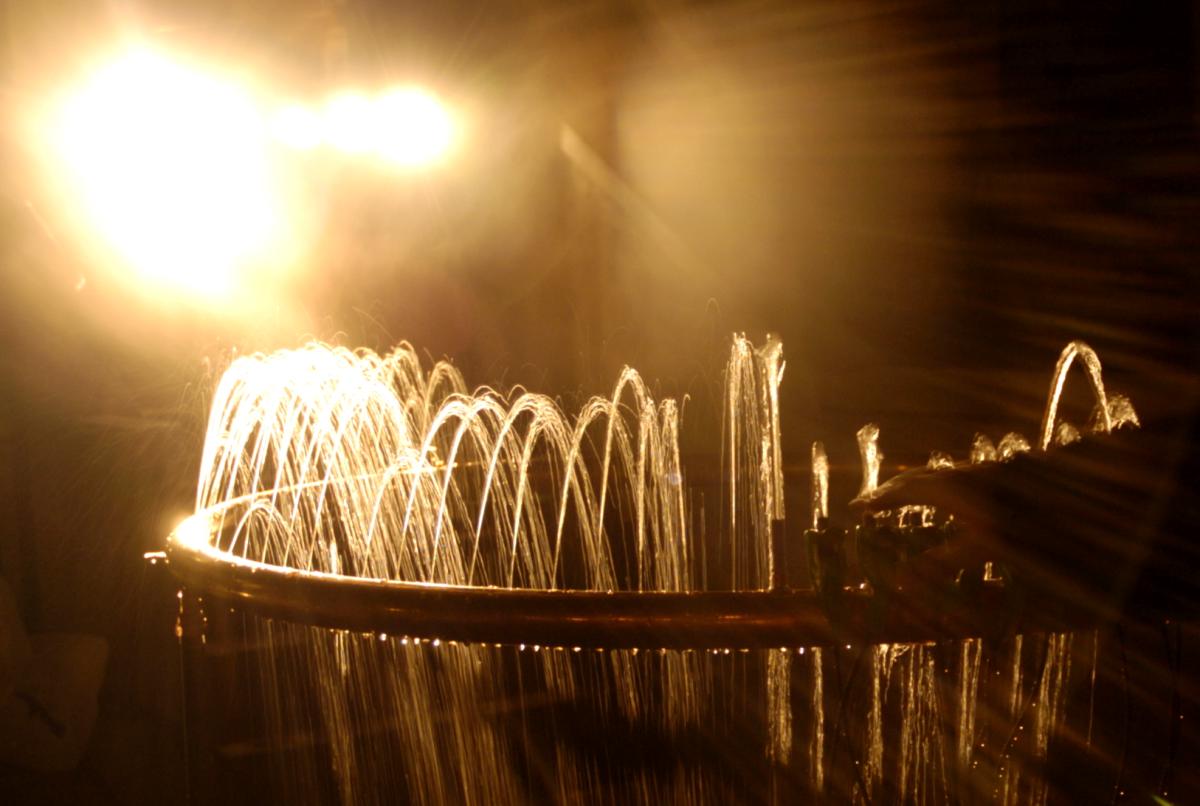
The new fluid-based musical instrument:
The new musical instrument
is simple to play. Leftmost: a 2 year-old plays
the well-known song ``Jingle Bells''.
Rightmost: a 61 note (61 jet)
prototype of the instrument can be used to play over a 5 octave range
with close jet spacing for easy chord formation.
Bass clef FUNtain and foot pedals
The funtain can be installed in any indoor/outdoor
greenhouse (sliding glass doors) in city parks, pools, and recreation areas,
so that it and the park can be used end enjoyed year-round yet open
up into the rest of the park in warm weather.
The bass clef funtain is an outdoor sculpture, and is meant to extend the
fun and frolic of the year-round treble clef funtain into the outdoors of
the park during the summer months.
Having two funtain sculptures on opposite sides of a greenhouse window will
create a wonderful dynamic of indoor/outdoor fun and frolic
on either side of the glass. The glass of the window suggests both
visibility and transparency in a kind of public/private dynamic,
where soundwave (acoustic) privacy is coupled with lightwave visibility.
This kind of interaction calls to mind the recording studio or radio station
aural aesthetic.
A detailed rendering of the bass clef FUNtain is shown below:
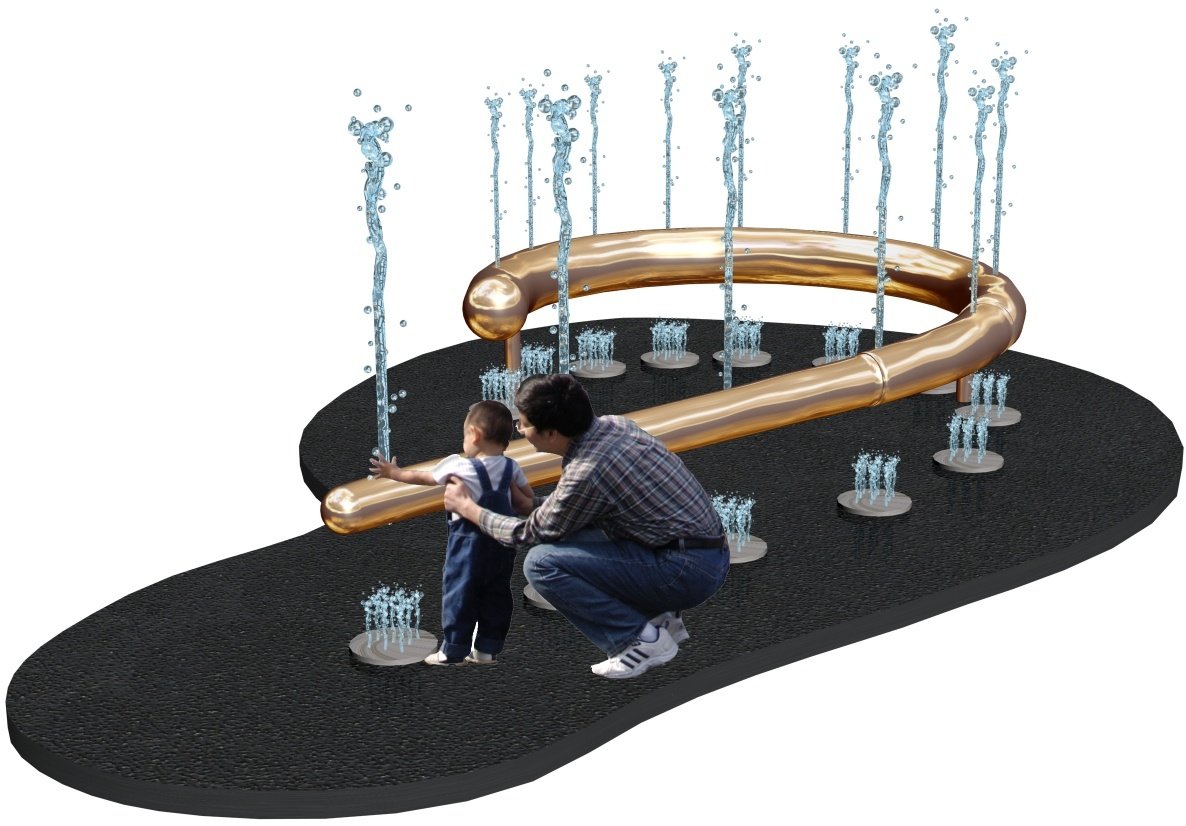
There are jets on the sculpture itself, as well as ground nozzles under
it. The ground nozzles under it also have a similar fluid user interface
in which sub-bass notes can be played by stepping on the water jets to
block the fluid flow from these ground nozzles. The sub-bass notes play
subsonic sounds
like the foot pedals
of a church organ, (many such organs can produce subsonic
sound below the range of audible hearing).
It is expected that the bass clef funtain would be used directly for fun
and frolic approximately five months of the year. This time could be
extended by the installation of an urban beach (``urbeach'')
space that includes heated lounge chairs outside. This
teach-beach would illustrate concepts of renewable energy,
by way of a solar heating installation, to teach the principles
of sustainable development, in a fun beach-like setting.
The result would also be warmer water for the outdoor bass clef funtain,
as well as heated spaces, to extend the summer
feel of the place through September and into late October.
Because the outdoor patio space is sheltered by buildings, etc., solar
collectors will be able to make this urbeach usable for approximately seven
months a year.
Beyond that time, the bass clef funtain can still operate as an
interactive peripheral to the treble clef funtain, since it is visible
out the greenhouse window behind the treble clef funtain.
Because of solar heating, it is expected that the bass clef funtain can
run year-round (as a peripheral to the treble funtain)
without freezing up, even though it would be too cold to
be outside in a bathing suit during the winter.
Ideally, an urban renewable energy beach setting outside
would comprise various sculptures that would supply energy to the rest of
the artwork and part of the greenhouse. These would consist of photovoltaic
energy sculptures, like the prototypes I built at my 330 Dundas Street studio.
Solar panels would ideally also be used to heat the water, thus making it
more comfortable to play. Even on hot summer days, it is nice if the water
is heated slightly, so that there is not such a cold shock in touching it.
--Steve Mann, 2004
Prof. S. Mann
Director, EyeTap Personal Imaging Laboratory (ePi Lab)
University of Toronto,
Department of Electrical and Computer Engineering
A similar musical waterpark feature:
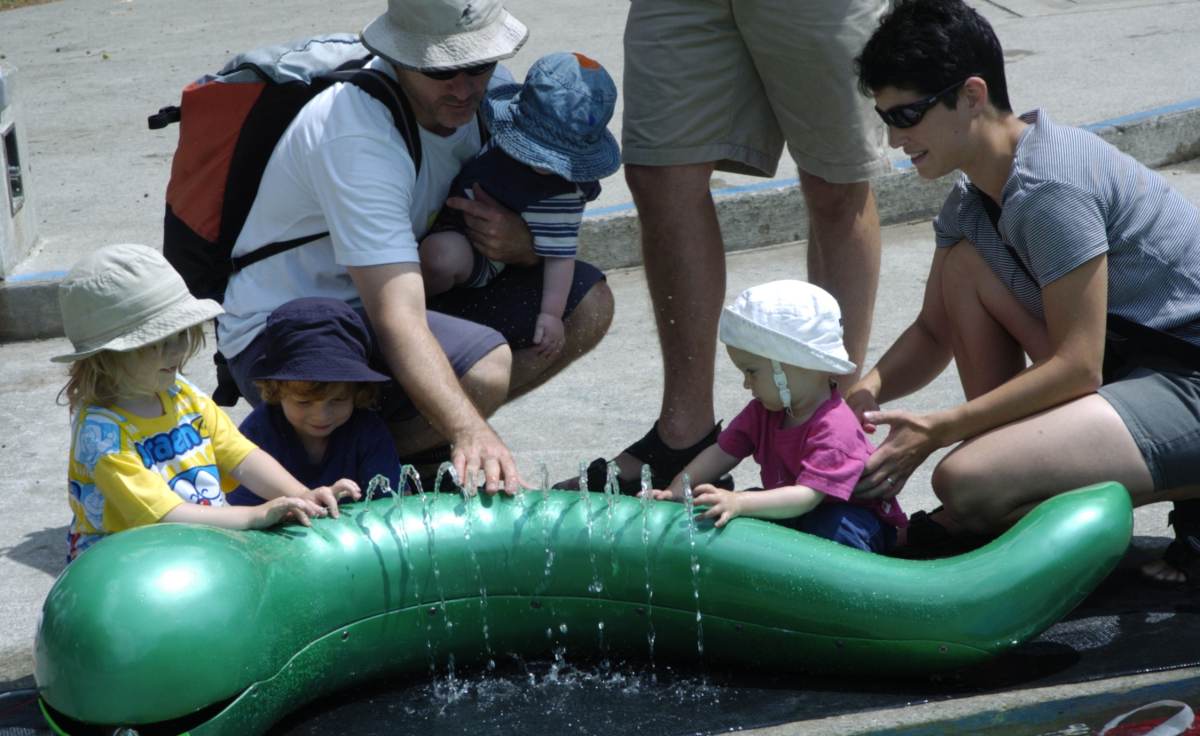
scienceimmersion/bassfuntainwithpeople.jpg
scienceimmersion/boyinfun.jpg
funtain_in_sf_atrium/
http://wearcam.org/cfp2005/cfp2005pictures/funtain.htm
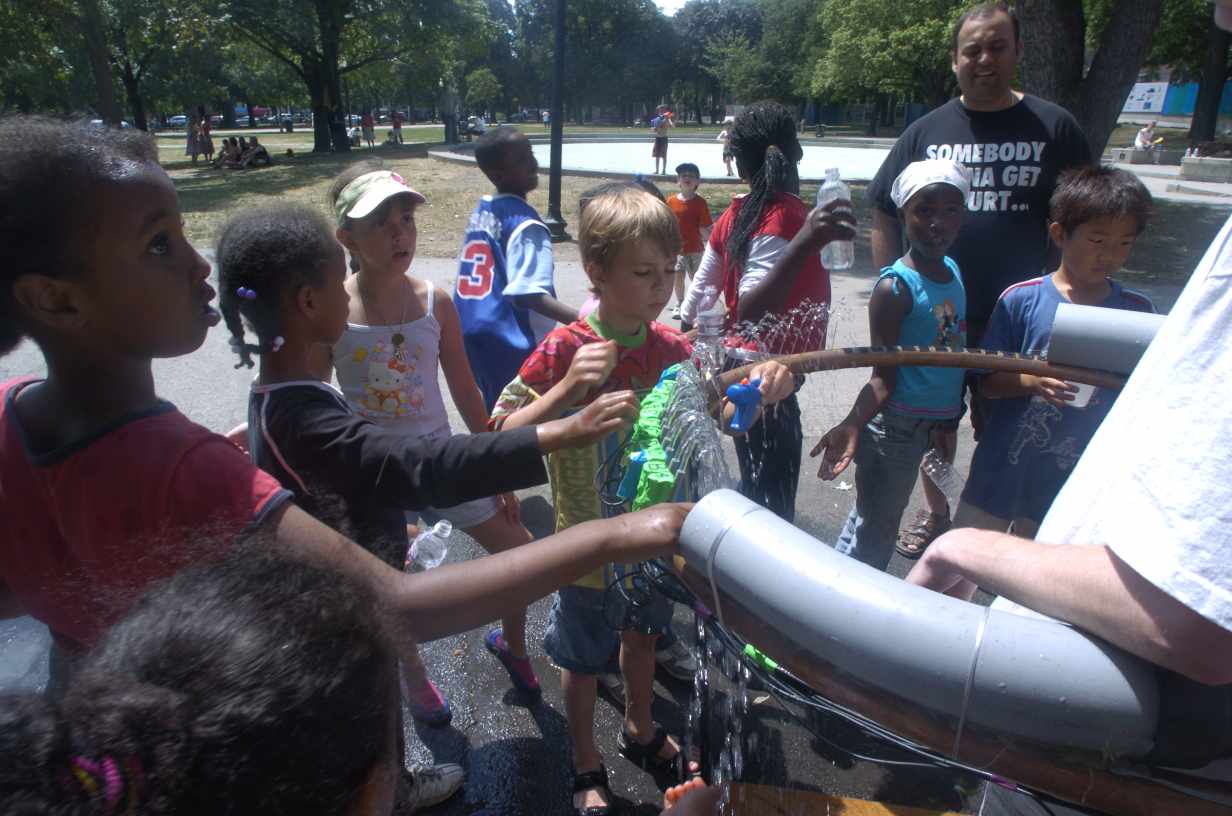
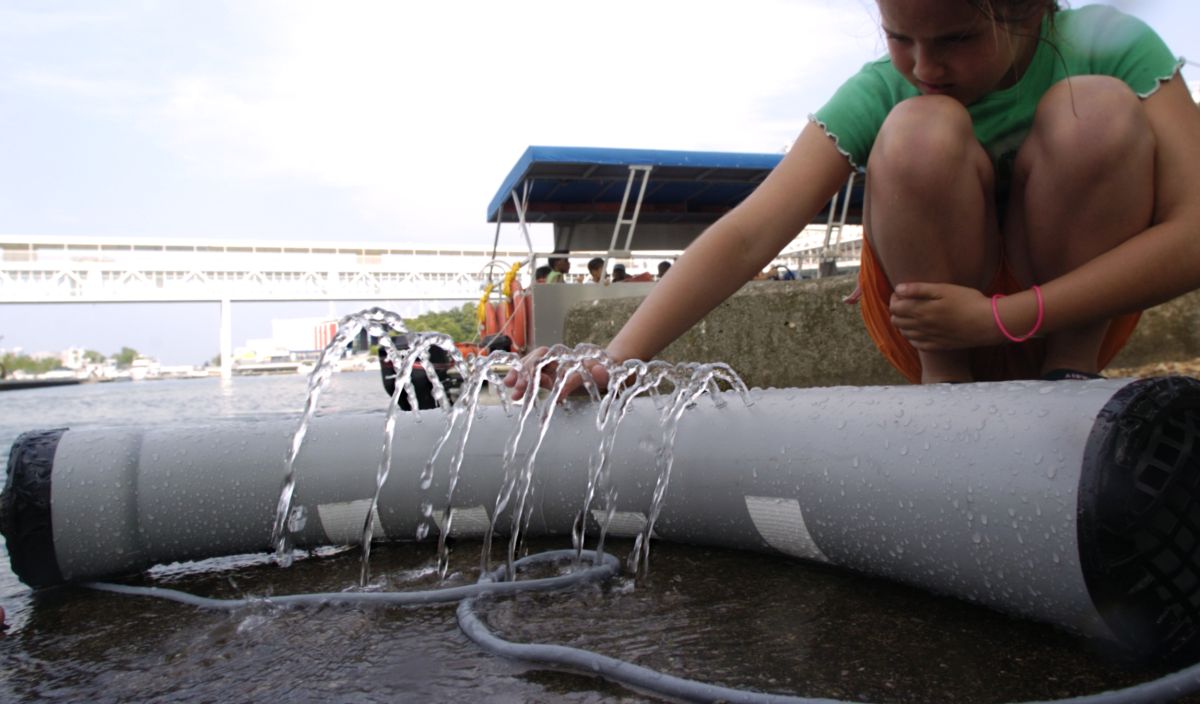
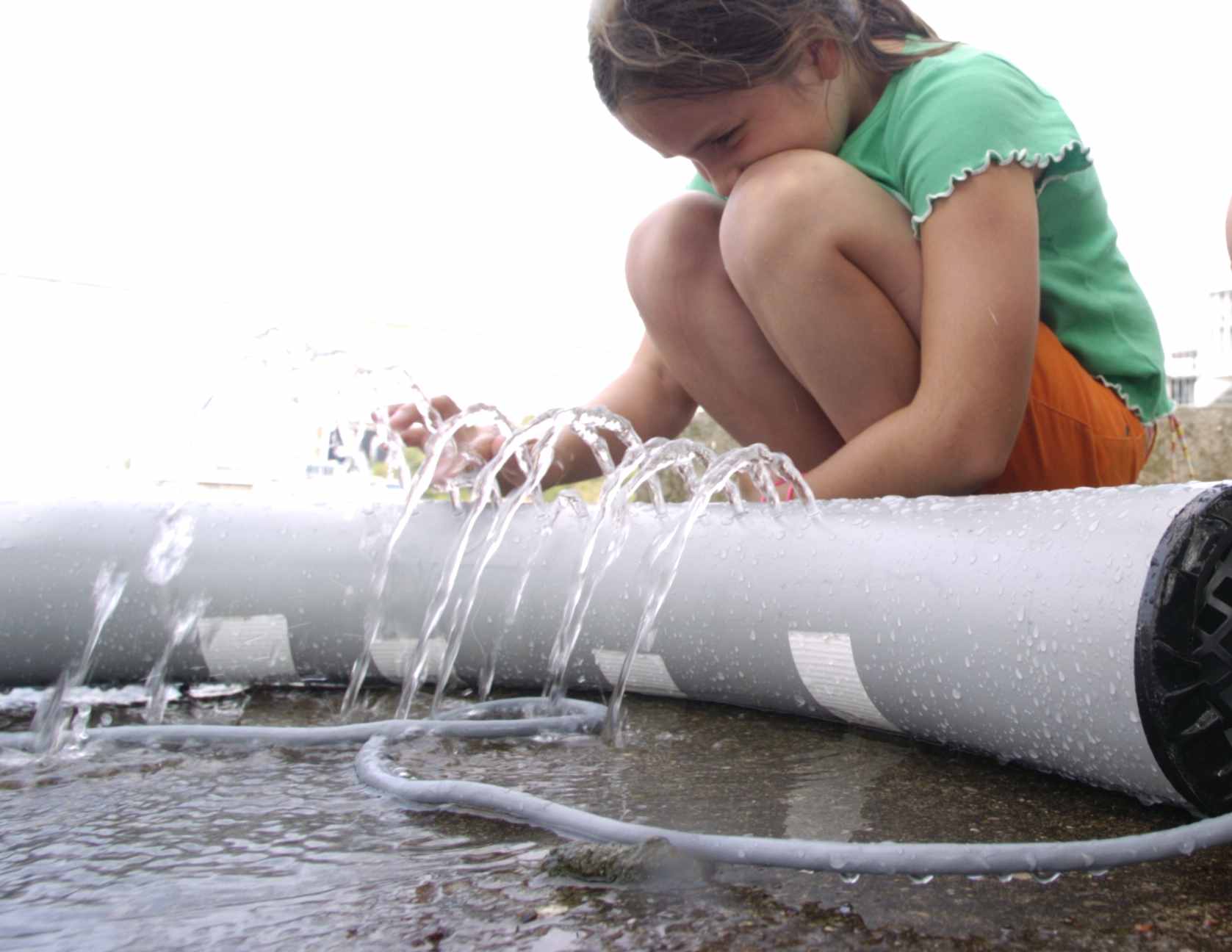


 It functions as a musical instrument ---
a water instrument
that is played like a flute, by blocking various holes
along the length of the sculpture. But instead of blocking air as
with a flute, the sculpture is played by blocking water jets.
It functions as a musical instrument ---
a water instrument
that is played like a flute, by blocking various holes
along the length of the sculpture. But instead of blocking air as
with a flute, the sculpture is played by blocking water jets.




